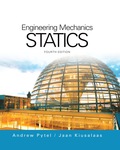
Concept explainers
The brake pads at C and D are pressed against the cylinder by the spring BF. The coefficient of static friction between each pad and the cylinder is 0.15. Find the smallest tension in the spring that would prevent the cylinder from rotating when the clockwise couple
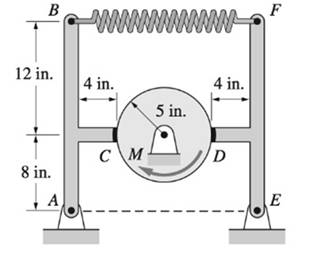
Smallest tension in the spring
Answer to Problem 7.8P
The smallest tension
Explanation of Solution
Given information:

The co-efficient of static friction between pad and cylinder is 0.15.
Couple M is equal to
If there is no relative motion between two surfaces that are in contact, The relationship between normal force
Steps to follow in the equilibrium analysis of a body are:
1. Draw the free body diagram.
2. Write the equilibrium equations.
3. Solve the equations for the unknowns.
Calculation:
FBD of EF
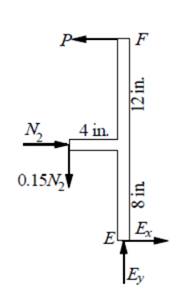
Assume
Assume
For the equilibrium of above section, the bending moment about point E is equal to zero.
FBD of AB
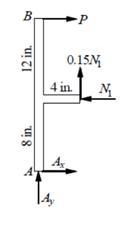
Assume
Assume
For the equilibrium of above section, the bending moment about point A is equal to zero.
FBD of the cylinder
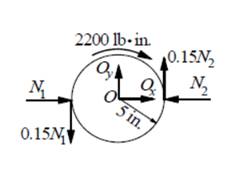
For the equilibrium of above section, the bending moment about point O is equal to zero.
Substitute and solve
Conclusion:
The smallest tension
Want to see more full solutions like this?
Chapter 7 Solutions
International Edition---engineering Mechanics: Statics 4th Edition
- I need expert handwritten solutions, don't use Artificial intelligencearrow_forwardConsider the combined gas-steam power cycle. The topping cycle is a gas-turbine cycle that has a pressure ratio of 8. Air enters the compressor at 300 K and the turbine at 1300 K. The isentropic efficiency of the compressor is 80%, and that of the gas turbine is 85%. The bottoming cycle is a simple Rankine cycle operating between the pressure limits of 7 MPa and 5 kPa. Steam is heated in a heat exchanger by the exhaust gases to a temperature of 500°C and the isentropic efficiency of the turbine is 90 %. The exhaust gases leave the heat exchanger at 450 K. Considering the mass flow rate steam as 1 kg/s, determine: A) Net power, B) Total input heat, C) Total entropy generation, D) Energy efficiency, E) Exergy efficiency, F) T-s diagram Solve by EES Compressor Air -③ in Exhaust gases Pump Combustion chamber Gas turbine Gas cycle Heat exchanger Condenser Steam Steam turbine cyclearrow_forwardI need expert solution s to this question, don't use Artificial intelligencearrow_forward
- I need solutions to this questions Don't use Artificial intelligencearrow_forwardPlease consider the following closed-loop Multiple-Input Multiple-Output (MIMO) control system: R₁(s) and R2(s) are the reference signals (or inputs), • G₁(s) (where i = 1,2,3,4,5) are the plant transfer functions, • C₁(s) and C2(s) are the responses (or system outputs), • All of them are in Laplace domain. R2 + R₁ + + G₂(s) G3(S) Tasks: G5(s) G4(s) + G₁(s) می a) Please derive the transfer function between C₁ (s) and R₂(s) (i.e., find R₂(s) (10 marks) (10 marks) b) Please derive the transfer function between C₂(s) and R₁(s) (i.e., find C2 (s)). R₁(s) Hint: Please carefully analyse how the signals interact with the plants G₁(s) and find all paths fromarrow_forwardMột thanh dài L = 2,5 m được nối bằng chốt với một con lăn ở A. Con lăn chuyển động dọc theo một đường ray nằm ngang như hình vẽ với VA 5 m/s. Xác định vận tốc của điểm C (trung điểm của thanh AB) = tại thời điểm 0 = 33° và O = 0.4 rad/s. A. v = (-5.42+0.272})(m/s) C. v = (5.421+0.272})(m/s) B. v =(0.272i+5.42j)(ms) D. (5.42-0.272)(m/s) = C Barrow_forward
- The simulink and Matlab part are the prioritized areas please.arrow_forwardPlease do not rely too much on chatgpt, because its answer may be wrong. Please consider it carefully and give your own answer. You can borrow ideas from gpt, but please do not believe its answer.Very very grateful! Please do not copy other's work,i will be very very grateful!!arrow_forwardAn industrial burner uses natural gas as fuel. The natural gas consists primarily of CH4 with small quantities of several other light hydrocarbons and can be represented as C1.16H4.32 To achieve low emissions of oxides of nitrogen, the burner operates lean at equivalence ratio of 0.4. Assume complete combustion and answer the following questions. i) What is the operating air-fuel ratio (i.e. mass air/mass of fuel)? [6 marks] ii) What is the percent excess air in the combustion products? [3 marks] iii) What is the oxygen (O2) mole fraction in the combustion products? [6 marks]arrow_forward
 International Edition---engineering Mechanics: St...Mechanical EngineeringISBN:9781305501607Author:Andrew Pytel And Jaan KiusalaasPublisher:CENGAGE L
International Edition---engineering Mechanics: St...Mechanical EngineeringISBN:9781305501607Author:Andrew Pytel And Jaan KiusalaasPublisher:CENGAGE L
